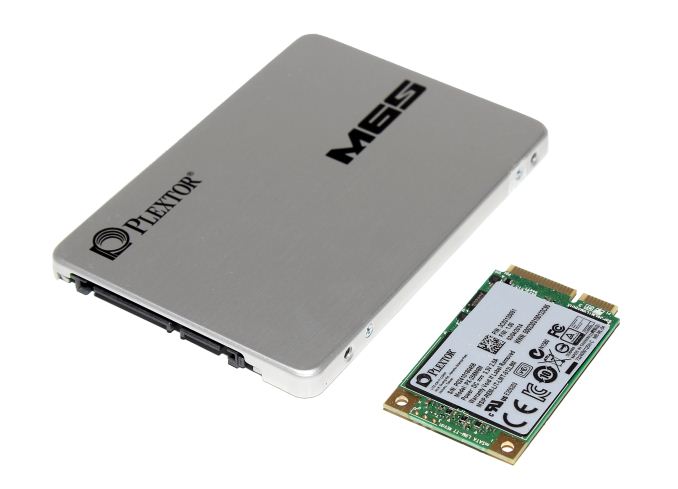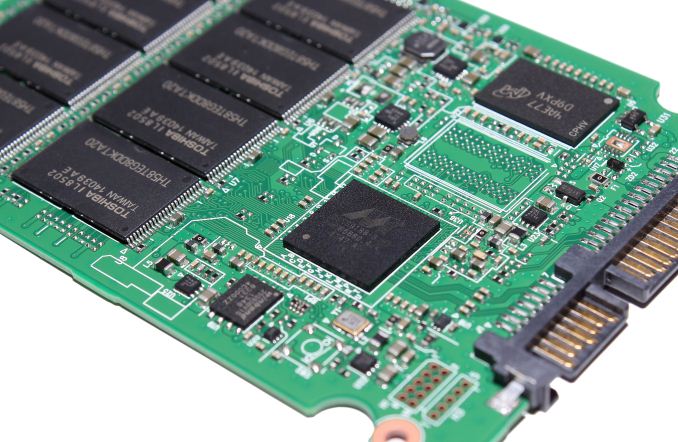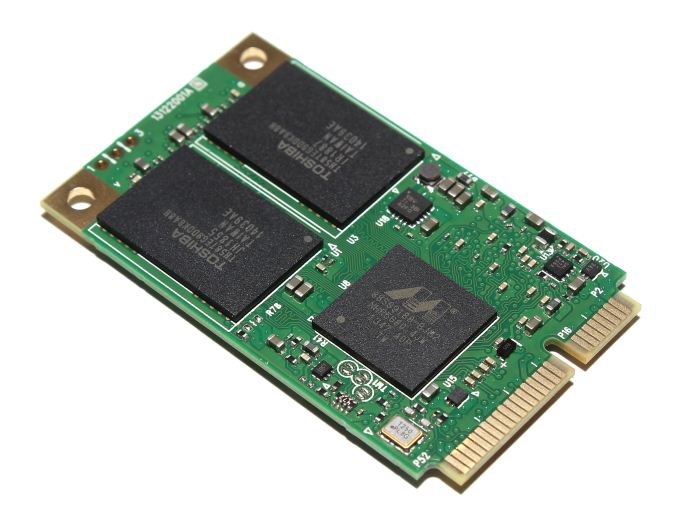Plextor M6S & M6M (256GB) Review
by Kristian Vättö on April 10, 2014 6:00 AM EST
Continuing our spring full of SSDs, the next drives under the scope are Plextor's M6S and M6M. Both drives were already showcased at CES this year but after a series of delays the release was pushed to April, which brings us to this review. Similar to the M5 series, the M6S is Plextor's mainstream offering with a focus on price, whereas the M6M is the mSATA variant of the M6S. The M5M was actually derived from the M5 Pro, so in this regard Plextor has slightly modified their strategy but I'm guessing this is to make the M6M more competitive in price. There will be an M6 Pro as well later this year and we'll probably know more after Computex (Plextor said June/July).
Photography by Juha Kokkonen
The biggest changes the M6S and M6M bring is Marvell's 88SS9188 controller and Toshiba's second generation 19nm MLC NAND. I'll cover the NAND in more detail in just a bit but the 9188 controller is essentially a "lite" version of the 9187 found in drives like the M5 Pro and Crucial M550. The amount of channels has been cut from eight to four, which is typical for budget and low power designs. We saw a similar trend with Marvell's previous generation 917x controllers where the 9174 was the full blown 8-channel design with 9175 being the cut down derivative. I believe the main market for the 9188 is mSATA drives because the spec only allows four NAND packages anyway, but Plextor has decided to use the 9188 controller in both the M6S and M6M.
| Plextor M6S Specifications | |||
| Capacity | 128GB | 256GB | 512GB |
| Controller | Marvell 88SS9188 | ||
| NAND | Toshiba A19nm MLC | ||
| Cache | 256MB | 512MB | 768MB |
| Sequential Read | 520MB/s | 520MB/s | 520MB/s |
| Sequential Write | 300MB/s | 420MB/s | 440MB/s |
| 4KB Random Read | 88K IOPS | 90K IOPS | 94K IOPS |
| 4KB Random Write | 75K IOPS | 80K IOPS | 80K IOPS |
| Endurance | 72TB (~66GB/day) | ||
| Warranty | Three years | ||
In terms of performance, there isn't any noticeable difference between the M6S and M6M. Similar to Crucial, Plextor is using 64Gbit die in the smaller capacity drives (see the table below for details) and 128Gbit in the larger ones. I covered this in the M550 review but in short the usage of smaller die increases parallelism, which in turn increases performance. For small drives the 128Gbit die is too large in capacity and the limited parallelism would lead to slow write speeds as we saw with the M500.
| Plextor M6M Specifications | ||||
| Capacity | 64GB | 128GB | 256GB | 512GB |
| Controller | Marvell 88SS9188 | |||
| NAND | Toshiba A19nm MLC | |||
| Cache | 128MB | 256MB | 512MB | 768MB |
| Sequential Read | 520MB/s | 520MB/s | 520MB/s | 520MB/s |
| Sequential Write | 160MB/s | 340MB/s | 440MB/s | 440MB/s |
| 4KB Random Read | 73K IOPS | 90K IOPS | 94K IOPS | 94K IOPS |
| 4KB Random Write | 42K IOPS | 76K IOPS | 80K IOPS | 80K IOPS |
| Endurance | 72TB (66GB/day) | |||
| Warranty | Three years | |||
Unfortunately, there is no hardware encryption support. This seems to be a feature that only a few manufacturers consider important for client drives, although I disagree because the value of the data we are carrying around is constantly increasing.
| M6S | M6M | ||||||
| Capacity | 128GB | 256GB | 512GB | 64GB | 128GB | 256GB | 512GB |
| # of NAND Packages | 8 | 8 | 8 | 4 | 4 | 4 | 4 |
| # of Die per Package | 2 x 8GB | 4 x 8GB | 4 x 16GB | 2 x 8GB | 4 x 8GB | 4 x 16GB | 8 x 16GB |
There is no NAND level redundancy either, which is also becoming a standard. The need for redundancy of course depends on the NAND and its reliability, but as we move to smaller lithographies it'll certainly be important to have some level of protection against page/block level failures. Plextor does have fairly strict quality control, though, as every drive is tested for at least 48 continuous hours including idle and power cycling tests (which are often what causes issues). Such rigid testing can make NAND redundancy less needed but I'd still like to have at least some redundancy just in case.
Test System
| CPU |
Intel Core i5-2500K running at 3.3GHz (Turbo and EIST enabled) |
| Motherboard | AsRock Z68 Pro3 |
| Chipset | Intel Z68 |
| Chipset Drivers | Intel 9.1.1.1015 + Intel RST 10.2 |
| Memory | G.Skill RipjawsX DDR3-1600 4 x 8GB (9-9-9-24) |
| Video Card |
Palit GeForce GTX 770 JetStream 2GB GDDR5 (1150MHz core clock; 3505MHz GDDR5 effective) |
| Video Drivers | NVIDIA GeForce 332.21 WHQL |
| Desktop Resolution | 1920 x 1080 |
| OS | Windows 7 x64 |
Thanks to G.Skill for the RipjawsX 32GB DDR3 DRAM kit












30 Comments
View All Comments
prime2515103 - Thursday, April 10, 2014 - link
I find it disappointing how average Plextor has become, yet they keep their pricing at a point where one might expect to get something at least slightly exceptional.I do have an M5M in my laptop and haven't had any problems with it, so I'll give them that. The selection of mSATA drives was pretty sparse when I bought it though, and it was on sale for $108 (which was quite good at the time), otherwise it definitely would not have been my first choice.
Cellar Door - Thursday, April 10, 2014 - link
I agree, I will be going with samsung evo for my msata drive. Very disappointing for the price.Samus - Thursday, April 10, 2014 - link
M500 is still the best deal for an average, reliable SSD. Great for basic business and family PC's.rufuselder - Thursday, October 9, 2014 - link
Me too. But either way, there are some much better storage options out there. /Rufus from http://www.consumertop.com/best-computer-storage-g...dylan522p - Thursday, April 10, 2014 - link
That was good basic explanation of the differences between everyones NAND! Thanks for doing that.nathanddrews - Thursday, April 10, 2014 - link
The pictures of the IMFT and Samsung processes are all clean and uniform... the Toshiba and Hynix processes look like a 3-year-old with a crayon made them.zodiacsoulmate - Thursday, April 10, 2014 - link
yea... why they look like that? maybe they are hard to color? why they look so random...extide - Thursday, April 10, 2014 - link
LOL, I noticed that too, it's like, geez how does that stuff even work! Looks so sloppy!Kristian Vättö - Friday, April 11, 2014 - link
Keep in mind that the diameter of the photo is a few dozen nanometers and it's extremely hard to achieve 100% precision with lithographies that small. At least IMFT has been using air gaps before and it's a mature process for them but Toshiba and Hynix added them to the current generation, making it quite new for them.creed3020 - Thursday, April 10, 2014 - link
Kristian thanks for such an in-depth technical and product review. I really appreciate how in your reviews graphs are accompanied with text explaining the results and providing an opinion on the results. I can read a graph but interpretation of those graphs and data trends is often missing from reviews here at AT.I am surprised that such a new drive isn't also available in M2 format but I guess they have the M6e for that. Is there a review of that drive coming as well?